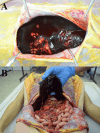A Case of a Boy With Undiagnosed Fibrolamellar Carcinoma Who Died Due to Severe Hemorrhage From Diaphragm
- PMID: 38817535
- PMCID: PMC11138234
- DOI: 10.7759/cureus.59355
A Case of a Boy With Undiagnosed Fibrolamellar Carcinoma Who Died Due to Severe Hemorrhage From Diaphragm
Abstract
An 11-year-old boy presented with vomiting and abdominal pain. Ultrasonography and blood tests revealed no abnormalities. He was diagnosed with viral gastroenteritis; however, the following morning, he was found dead in bed. Postmortem examination revealed that a 1,900 mL hemorrhage with strong coagulation from the diaphragm was the cause of death. He had no traumatic episodes, injuries, or a medical history of hemorrhagic diathesis. The presence of a fibrin-like clot indicated coagulation activation; however, most criteria for disseminated intravascular coagulation were not observed. Fibrolamellar carcinoma, a rare hepatocellular carcinoma, was found; however, liver disorder was not estimated based on the pathological findings. In conclusion, the mechanism of hemorrhage could not be explained. Although we were unable to identify the cause of the hemorrhage, we could not completely rule out the possibility that fibrolamellar carcinoma had an unknown influence on the hemorrhage. Given the limited number of studies on fibrolamellar carcinoma, we present a case of a boy with undiagnosed fibrolamellar carcinoma who died due to severe hemorrhage.
Keywords: child; fibrolamellar carcinoma; hemophagocytosis; internal hemorrhage; legal autopsy.
Copyright © 2024, Naito et al.
Conflict of interest statement
The authors have declared that no competing interests exist.
Figures





Similar articles
-
Fibrolamellar hepatocellular carcinoma: a case report.Malays J Pathol. 2001 Dec;23(2):115-8. Malays J Pathol. 2001. PMID: 12166592
-
Fibrolamellar hepatocellular carcinoma presenting as cholestatic jaundice: An unusual presentation of a rare disease.Indian J Pathol Microbiol. 2023 Apr-Jun;66(2):385-387. doi: 10.4103/ijpm.ijpm_316_21. Indian J Pathol Microbiol. 2023. PMID: 37077092
-
Case Report of Fibrolamellar Hepatocellular Carcinoma in A 15-Year-old Male.Med Arch. 2022 Oct;76(5):387-390. doi: 10.5455/medarh.2022.76.387-390. Med Arch. 2022. PMID: 36545449 Free PMC article.
-
Fibrolamellar carcinoma presenting as a pancreatic mass: case report and review of the literature.J Pediatr Hematol Oncol. 2009 May;31(5):370-2. doi: 10.1097/MPH.0b013e3181984f7f. J Pediatr Hematol Oncol. 2009. PMID: 19415023 Review.
-
[76-year-old patient with adenocarcinoma of the rectum and fibrolamellar hepatocellular 2d carcinoma. Case report with literature review of hepatocellular carcinoma of the fibrolamellar type].Wien Klin Wochenschr. 1987 Jul 17;99(14):505-9. Wien Klin Wochenschr. 1987. PMID: 2820156 Review. German.
References
-
- High proportion of patients with bleeding of unknown cause in persons with a mild-to-moderate bleeding tendency: Results from the Vienna Bleeding Biobank (VIBB) Gebhart J, Hofer S, Panzer S, et al. Haemophilia. 2018;24:405–413. - PubMed
-
- High prevalence of bleeders of unknown cause among patients with inherited mucocutaneous bleeding. A prospective study of 280 patients and 299 controls. Quiroga T, Goycoolea M, Panes O, et al. Haematologica. 2007;92:357–365. - PubMed
-
- A pathological study of the disseminated intravascular coagulation (DIC) syndrome. I. Experimental studies on the pathological properties of fibrin thrombi in DIC of rabbits induced by endotoxin. (Article in Japanese) Yamahata K, Narimatsu E. Sapporo Med J. 1980;49:128–145.
-
- Disseminated intravascular coagulation. Gando S, Levi M, Toh CH. Nat Rev Dis Primers. 2016;2:16037. - PubMed
Publication types
LinkOut - more resources
Full Text Sources
